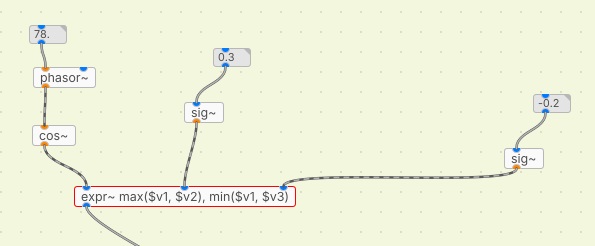I am strugling with the expr~ when the function has multiple arguments
Example , a simple clipper which I assume needs the fucntion min and max
expr~ min ( $v1,$vs2)
This works where $v1 is the input signal , and $v2 is a number ( using sig~to convert ) to clip it (one part only )
Now the second part , when using a comma in the same expression to get the other clip value the expression goes red .
In supercolldier it's pretty easy you had the function , open the parenthesis and the first input was mostly the signal , and then the values like this
clip~ ( input signal , -0.5, 0.5)
Translated to pure data it woud be this
expr~ min ( $v1,$v2) max($v1,$v3)
I cant find which sign to use to separate the functions , I don't need the semicolos since these will create multiple outputs which I don't need
All help welcome

-
need some help with expr~
-
Wouldn't it be
expr~ max( min($v1, $v2), $v3 )If v1 is the signal, v2 is the upper limit and v3 is the lower limit. (If v2 is the lower limit, then exchange mac and min in the formula.)
hjh
-
@ddw_music said:
max( min($v1, $v2), $v3 )
I see , the min is nested inside the max and is the first argument of max
I am making the old skool trick of a rounded clipper , works brillianty (I know tanh is easier ...)
thanks ;
expr~ sin(max( min($v1, $v2), $v3 ))
